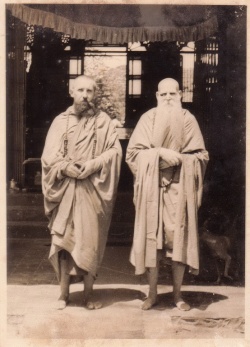Difference between revisions of "The Beginning of Buddhism in Estonia: Karl Tõnisson’s actions"
(Created page with "thumb|250px|Lustig ja Tennisons Shwedagon 1954 Karl Tõnisson’s actions in Estonia did not extend to the creation of practica...") |
|||
| Line 1: | Line 1: | ||
[[File:Lustig ja Tennisons Shwedagon 1954.JPG|thumb|250px|Lustig ja Tennisons Shwedagon 1954]] | [[File:Lustig ja Tennisons Shwedagon 1954.JPG|thumb|250px|Lustig ja Tennisons Shwedagon 1954]] | ||
| − | Karl Tõnisson’s actions in Estonia did not extend to the creation of practical Buddhism, because no buildings or objects (temples, stupas etc.) were established by him. Tõnisson mainly published books, and held lectures and lamaistic services in different places. With regards to Lustig as the student of Tõnisson, after meeting Tõnisson, Lustig left for Asia and he didn’t do any Buddhist activities in Estonia, so his contribution to Estonian Buddhism is indirect and only expressed in the anti-Soviet attitude that he occasionally demonstrated in Asia. | + | Karl Tõnisson’s [[actions]] in {{Wiki|Estonia}} did not extend to the creation of practical [[Buddhism]], because no buildings or [[objects]] ([[temples]], [[stupas]] etc.) were established by him. Tõnisson mainly published [[books]], and held lectures and lamaistic services in different places. With regards to Lustig as the student of Tõnisson, after [[meeting]] Tõnisson, Lustig left for {{Wiki|Asia}} and he didn’t do any [[Buddhist]] [[activities]] in {{Wiki|Estonia}}, so his contribution to Estonian [[Buddhism]] is indirect and only expressed in the anti-Soviet [[attitude]] that he occasionally demonstrated in {{Wiki|Asia}}. |
| − | Tõnisson was extremely talented and witty in his actions and should be considered a Mahasiddha because of his colourful behaviour and lifestyle. Tõnisson’s contemporaries, uneducated in Buddhism, knew nothing about Mahasiddhas, yogis or Buddhism. So Tõnisson was considered to be a very strange individual. During the Soviet occupation, he was called a “rantipole freak” by the writers Remsujev and Gerodnik, who considered Tõnisson to be a tool of imperialists and an enemy of the Estonian people. The same view was held by Soviet orientalists. | + | Tõnisson was extremely talented and witty in his [[actions]] and should be considered a [[Mahasiddha]] [[because of]] his colourful {{Wiki|behaviour}} and lifestyle. Tõnisson’s contemporaries, uneducated in [[Buddhism]], knew [[nothing]] about [[Mahasiddhas]], [[yogis]] or [[Buddhism]]. So Tõnisson was considered to be a very strange {{Wiki|individual}}. During the Soviet occupation, he was called a “rantipole freak” by the writers Remsujev and Gerodnik, who considered Tõnisson to be a tool of imperialists and an enemy of the Estonian [[people]]. The same [[view]] was held by Soviet orientalists. |
{{R}} | {{R}} | ||
Latest revision as of 05:11, 17 September 2013
Karl Tõnisson’s actions in Estonia did not extend to the creation of practical Buddhism, because no buildings or objects (temples, stupas etc.) were established by him. Tõnisson mainly published books, and held lectures and lamaistic services in different places. With regards to Lustig as the student of Tõnisson, after meeting Tõnisson, Lustig left for Asia and he didn’t do any Buddhist activities in Estonia, so his contribution to Estonian Buddhism is indirect and only expressed in the anti-Soviet attitude that he occasionally demonstrated in Asia.
Tõnisson was extremely talented and witty in his actions and should be considered a Mahasiddha because of his colourful behaviour and lifestyle. Tõnisson’s contemporaries, uneducated in Buddhism, knew nothing about Mahasiddhas, yogis or Buddhism. So Tõnisson was considered to be a very strange individual. During the Soviet occupation, he was called a “rantipole freak” by the writers Remsujev and Gerodnik, who considered Tõnisson to be a tool of imperialists and an enemy of the Estonian people. The same view was held by Soviet orientalists.
